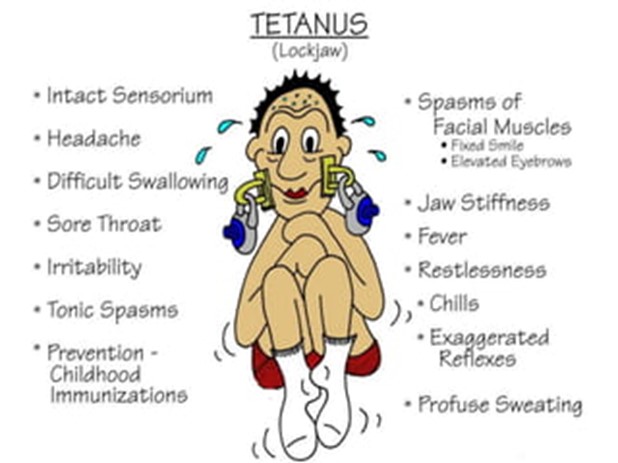Signs and symptoms

- The signs and symptoms of tetanus vary depending on the type, severity, and location of muscle involvement. -They usually appear within 3 to 21 days after exposure to C. tetani spores (incubation period), with an average of 8 days[.
- The most common type of tetanus is generalized tetanus (80% of cases), which affects all skeletal muscles[. The first symptom is usually trismus (lockjaw), which is difficulty opening the mouth due to spasms of the masseter muscles[. This is followed by risus sardonicus, which is a grimace or smile caused by spasms of the facial muscles[.
- Other symptoms of generalized tetanus include dysphagia (difficulty swallowing), opisthotonos (arching of the back), sardonic laughter (involuntary laughter), laryngeal spasm (difficulty breathing), tachycardia (rapid heart rate), hypertension (high blood pressure), diaphoresis (sweating), fever, and dysuria (difficulty urinating)[.
- The muscle spasms are triggered by stimuli such as noise, light, touch, or movement. They can last from seconds to minutes and can be very painful and exhausting. They can also lead to complications such as fractures, dislocations, rhabdomyolysis (muscle breakdown), respiratory failure, aspiration pneumonia, pulmonary embolism, and cardiac arrhythmias[.
- The mortality rate of generalized tetanus is 10% to 20%, with higher rates in neonates and elderly[.
- The second most common type of tetanus is localized tetanus (10% of cases), which affects only the muscles near the site of infection[. The symptoms are similar to those of generalized tetanus but milder and less widespread. The prognosis is better than that of generalized tetanus[.
- The rarest type of tetanus is cephalic tetanus (<1% of cases), which affects only the cranial nerves, especially the facial nerve[. The symptoms include facial paralysis, ptosis (drooping eyelid), diplopia (double vision), dysphagia, and dysarthria (slurred speech)[. Cephalic tetanus can progress to generalized tetanus or result in death due to respiratory failure[.
Nursing Test Bank
Naxlex Comprehensive Predictor Exams
Questions on Signs and symptoms
Correct Answer is B
Explanation
Correct Answer is ["A","C","D"]
Explanation
Correct Answer is C
Explanation
Correct Answer is A
Explanation
Correct Answer is C
Explanation
Correct Answer is B
Explanation
Correct Answer is D
Explanation
Correct Answer is B
Explanation
Search Here
Related Topics
More on Nursing
Free Nursing Study Materials
Access to all study guides and practice questions for nursing for free.
- Free Nursing Study Trials
- Free Nursing Video tutorials
- Free Nursing Practice Tests
- Free Exam and Study Modes
- Free Nursing Revision Quizlets
